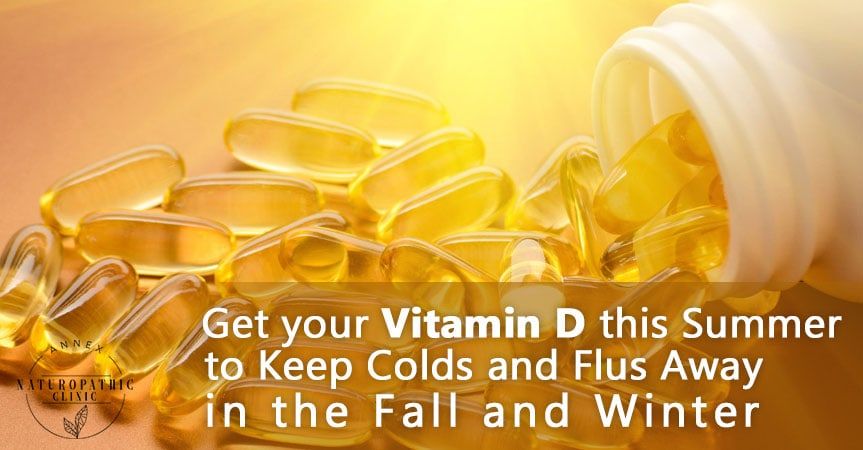Get your Vitamin D this Summer to Keep Colds and Flus Away in the Fall and Winter
Posted on June 20th, 2017

With summer finally here, you have the next 3 months to stock up on the important essential Sunshine vitamin, otherwise known as Vitamin D.
What Is Vitamin D?
Vitamin D is actually not a vitamin but is a hormone with beneficial effects on the immune system. It is widely known that we are able to synthesize Vitamin D on our own with the help of the wonderful summer sun, but in the dreary fall and winter months, achieving optimal levels of this “miracle” vitamin is difficult for us living in the Northern Hemisphere.
Vitamin D is commonly known to aid in the absorption of calcium, which leads to optimal bone health and function, but new research demonstrates that this hormone does much more.
Along with calcium regulation, Vitamin D is also a powerful immune and hormone modulator, which makes it useful in treating conditions such as hypertension, cancer, depression (especially seasonal), and prevention of the common cold and flu.
It has been demonstrated that those with low vitamin D levels have a greater risk of catching cold and flu bugs, and with limited amounts of sun exposure during the dark winter months, your levels of D will significantly drop.
Vitamin D helps your body fight off these infections by reinforcing the protective surface barriers of the skin, lungs, and the gastrointestinal tract, preventing unwanted microbes from entering the body through these routes.
This is especially important in those who are most susceptible to infection, such as people with weak lungs, (asthmatics, smokers, etc..) and those with general immune dysfunction, usually stemming from poor diet and lifestyle habits.
Vitamin D also modulates the immune system by activating T-cells, cells which help recognize and promote the destruction of microbes, while decreasing inflammation caused by an over-active immune system.
How Much Vitamin D Should You Take?
So what are adequate amounts of Vitamin D? According to Health Canada, recommended adequate intakes of Vitamin D is set at 200 IU daily (400 – 600 IU for those >50 years of age).
However, recent research has found that 200 IU/day (even up to 800 IU) is ineffective in achieving adequate levels of vitamin D in the bloodstream. Therefore higher dosages of vitamin D (at least 1000 IU) should be recommended by health care professionals to obtain adequate levels in the blood stream.
While sunlight is one of the best ways of achieving optimal vitamin D levels so stock up this summer as optimal levels are difficult to achieve in the winter months, or if you’re stuck in the office all day.
All you need is 10 minutes in the mid-day sun in shorts in a T-shirt (without sunscreen) to get a mighty dose of vitamin D (10 000IU), but make sure to limit your time in the sun without sunblock to prevent skin damage.
For darker skinned individuals, it’s more difficult to produce vitamin D through sun exposure alone, therefore vitamin D should be obtained through diet, longer sun exposure (but not too long to avoid skin damage, likely around 15-20 minutes maximum) and/or though supplementation.

Other Sources Of Vitamin D
For the month with low sun exposure, there are various sources of vitamin D you can obtain through diet, such as though fish, eggs and fortified dairy and soy products.
However, it is recommended to also use high quality vitamin D supplement in conjunction with diet, as diet alone may not reach the optimal dosage and/or some of the fortified foods (dairy and soy) may not agree with your digestive system.
This summer, make sure to spend some much-needed time in the sun to optimize your vitamin D levels for the fall and winter season, when sunlight is sparse and darkness prevails. This will keep your immune system strong and protect your body from cold and flus.
Talk to a naturopathic doctor if you’re curious about how to supplement vitamin D in the winter. Vitamin D testing is done in October in order to see what your status is going in to the low-light seasons, and a proper dose of vitamin D supplementation can be recommended based on your serum levels to maintain what you obtained in the summer
If you’re curious to learn more about this subject or would like to consult with one of our NDs feel free to
book a visit or contact us.
Yours in Health
Dr. Tanya Lee, N.D
Annex Naturopathic Clinic
572 Bloor St W #201, Toronto, ON M6G 1K1
- https://goo.gl/maps/uVRBvcyoUa62
References:
Harris SS Vitamin D and African Americans.J Nutr. 2006 Apr;136(4):1126-9.
To find additional ideas on health, wellness, and alternative medicine, please visit us here: naturapathic doctors
